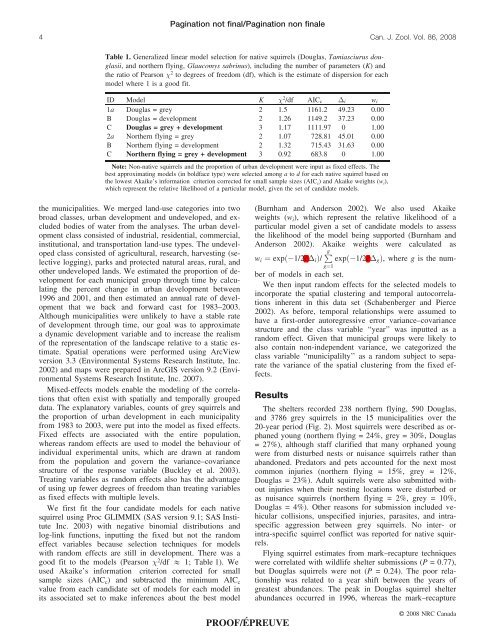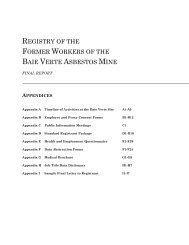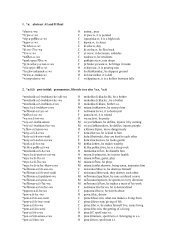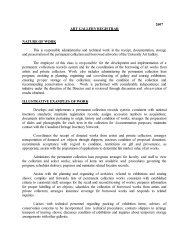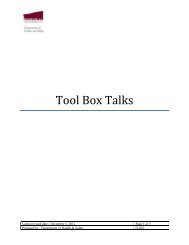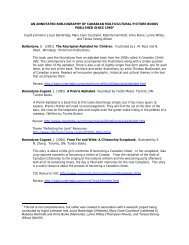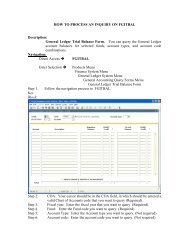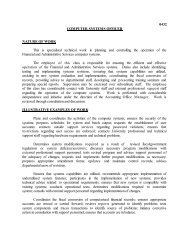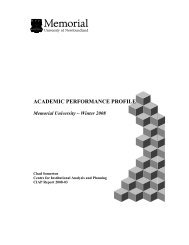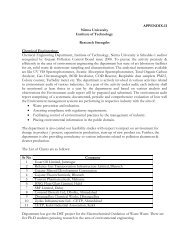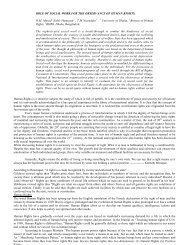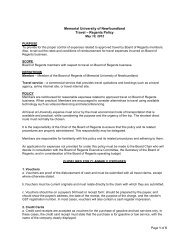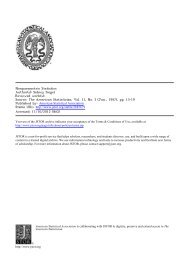Positive relationship between non-native and native squirrels in an ...
Positive relationship between non-native and native squirrels in an ...
Positive relationship between non-native and native squirrels in an ...
You also want an ePaper? Increase the reach of your titles
YUMPU automatically turns print PDFs into web optimized ePapers that Google loves.
Pag<strong>in</strong>ation not f<strong>in</strong>al/Pag<strong>in</strong>ation <strong>non</strong> f<strong>in</strong>ale<br />
4 C<strong>an</strong>. J. Zool. Vol. 86, 2008<br />
Table 1. Generalized l<strong>in</strong>ear model selection for <strong>native</strong> <strong>squirrels</strong> (Douglas, Tamiasciurus douglasii,<br />
<strong><strong>an</strong>d</strong> northern fly<strong>in</strong>g, Glaucomys sabr<strong>in</strong>us), <strong>in</strong>clud<strong>in</strong>g the number of parameters (K) <strong><strong>an</strong>d</strong><br />
the ratio of Pearson 2 to degrees of freedom (df), which is the estimate of dispersion for each<br />
model where 1 is a good fit.<br />
ID Model K 2 /df AIC c i w i<br />
1a Douglas = grey 2 1.5 1161.2 49.23 0.00<br />
B Douglas = development 2 1.26 1149.2 37.23 0.00<br />
C Douglas = grey + development 3 1.17 1111.97 0 1.00<br />
2a Northern fly<strong>in</strong>g = grey 2 1.07 728.81 45.01 0.00<br />
B Northern fly<strong>in</strong>g = development 2 1.32 715.43 31.63 0.00<br />
C Northern fly<strong>in</strong>g = grey + development 3 0.92 683.8 0 1.00<br />
Note: Non-<strong>native</strong> <strong>squirrels</strong> <strong><strong>an</strong>d</strong> the proportion of urb<strong>an</strong> development were <strong>in</strong>put as fixed effects. The<br />
best approximat<strong>in</strong>g models (<strong>in</strong> boldface type) were selected among a to d for each <strong>native</strong> squirrel based on<br />
the lowest Akaike’s <strong>in</strong>formation criterion corrected for small sample sizes (AIC c ) <strong><strong>an</strong>d</strong> Akaike weights (w i ),<br />
which represent the relative likelihood of a particular model, given the set of c<strong><strong>an</strong>d</strong>idate models.<br />
the municipalities. We merged l<strong><strong>an</strong>d</strong>-use categories <strong>in</strong>to two<br />
broad classes, urb<strong>an</strong> development <strong><strong>an</strong>d</strong> undeveloped, <strong><strong>an</strong>d</strong> excluded<br />
bodies of water from the <strong>an</strong>alyses. The urb<strong>an</strong> development<br />
class consisted of <strong>in</strong>dustrial, residential, commercial,<br />
<strong>in</strong>stitutional, <strong><strong>an</strong>d</strong> tr<strong>an</strong>sportation l<strong><strong>an</strong>d</strong>-use types. The undeveloped<br />
class consisted of agricultural, research, harvest<strong>in</strong>g (selective<br />
logg<strong>in</strong>g), parks <strong><strong>an</strong>d</strong> protected natural areas, rural, <strong><strong>an</strong>d</strong><br />
other undeveloped l<strong><strong>an</strong>d</strong>s. We estimated the proportion of development<br />
for each municipal group through time by calculat<strong>in</strong>g<br />
the percent ch<strong>an</strong>ge <strong>in</strong> urb<strong>an</strong> development <strong>between</strong><br />
1996 <strong><strong>an</strong>d</strong> 2001, <strong><strong>an</strong>d</strong> then estimated <strong>an</strong> <strong>an</strong>nual rate of development<br />
that we back <strong><strong>an</strong>d</strong> forward cast for 1983–2003.<br />
Although municipalities were unlikely to have a stable rate<br />
of development through time, our goal was to approximate<br />
a dynamic development variable <strong><strong>an</strong>d</strong> to <strong>in</strong>crease the realism<br />
of the representation of the l<strong><strong>an</strong>d</strong>scape relative to a static estimate.<br />
Spatial operations were performed us<strong>in</strong>g ArcView<br />
version 3.3 (Environmental Systems Research Institute, Inc.<br />
2002) <strong><strong>an</strong>d</strong> maps were prepared <strong>in</strong> ArcGIS version 9.2 (Environmental<br />
Systems Research Institute, Inc. 2007).<br />
Mixed-effects models enable the model<strong>in</strong>g of the correlations<br />
that often exist with spatially <strong><strong>an</strong>d</strong> temporally grouped<br />
data. The expl<strong>an</strong>atory variables, counts of grey <strong>squirrels</strong> <strong><strong>an</strong>d</strong><br />
the proportion of urb<strong>an</strong> development <strong>in</strong> each municipality<br />
from 1983 to 2003, were put <strong>in</strong>to the model as fixed effects.<br />
Fixed effects are associated with the entire population,<br />
whereas r<strong><strong>an</strong>d</strong>om effects are used to model the behaviour of<br />
<strong>in</strong>dividual experimental units, which are drawn at r<strong><strong>an</strong>d</strong>om<br />
from the population <strong><strong>an</strong>d</strong> govern the vari<strong>an</strong>ce–covari<strong>an</strong>ce<br />
structure of the response variable (Buckley et al. 2003).<br />
Treat<strong>in</strong>g variables as r<strong><strong>an</strong>d</strong>om effects also has the adv<strong>an</strong>tage<br />
of us<strong>in</strong>g up fewer degrees of freedom th<strong>an</strong> treat<strong>in</strong>g variables<br />
as fixed effects with multiple levels.<br />
We first fit the four c<strong><strong>an</strong>d</strong>idate models for each <strong>native</strong><br />
squirrel us<strong>in</strong>g Proc GLIMMIX (SAS version 9.1; SAS Institute<br />
Inc. 2003) with negative b<strong>in</strong>omial distributions <strong><strong>an</strong>d</strong><br />
log-l<strong>in</strong>k functions, <strong>in</strong>putt<strong>in</strong>g the fixed but not the r<strong><strong>an</strong>d</strong>om<br />
effect variables because selection techniques for models<br />
with r<strong><strong>an</strong>d</strong>om effects are still <strong>in</strong> development. There was a<br />
good fit to the models (Pearson 2 /df & 1; Table 1). We<br />
used Akaike’s <strong>in</strong>formation criterion corrected for small<br />
sample sizes (AIC c ) <strong><strong>an</strong>d</strong> subtracted the m<strong>in</strong>imum AIC c<br />
value from each c<strong><strong>an</strong>d</strong>idate set of models for each model <strong>in</strong><br />
its associated set to make <strong>in</strong>ferences about the best model<br />
g¼1<br />
(Burnham <strong><strong>an</strong>d</strong> Anderson 2002). We also used Akaike<br />
weights (w i ), which represent the relative likelihood of a<br />
particular model given a set of c<strong><strong>an</strong>d</strong>idate models to assess<br />
the likelihood of the model be<strong>in</strong>g supported (Burnham <strong><strong>an</strong>d</strong><br />
Anderson 2002). Akaike weights were calculated as<br />
w i ¼ expð 1=2_c i Þ= Pg<br />
expð 1=2_c g Þ, where g is the number<br />
of models <strong>in</strong> each set.<br />
We then <strong>in</strong>put r<strong><strong>an</strong>d</strong>om effects for the selected models to<br />
<strong>in</strong>corporate the spatial cluster<strong>in</strong>g <strong><strong>an</strong>d</strong> temporal autocorrelations<br />
<strong>in</strong>herent <strong>in</strong> this data set (Schabenberger <strong><strong>an</strong>d</strong> Pierce<br />
2002). As before, temporal <strong>relationship</strong>s were assumed to<br />
have a first-order autoregressive error vari<strong>an</strong>ce–covari<strong>an</strong>ce<br />
structure <strong><strong>an</strong>d</strong> the class variable ‘‘year’’ was <strong>in</strong>putted as a<br />
r<strong><strong>an</strong>d</strong>om effect. Given that municipal groups were likely to<br />
also conta<strong>in</strong> <strong>non</strong>-<strong>in</strong>dependent vari<strong>an</strong>ce, we categorized the<br />
class variable ‘‘municipalilty’’ as a r<strong><strong>an</strong>d</strong>om subject to separate<br />
the vari<strong>an</strong>ce of the spatial cluster<strong>in</strong>g from the fixed effects.<br />
Results<br />
The shelters recorded 238 northern fly<strong>in</strong>g, 590 Douglas,<br />
<strong><strong>an</strong>d</strong> 3786 grey <strong>squirrels</strong> <strong>in</strong> the 15 municipalities over the<br />
20-year period (Fig. 2). Most <strong>squirrels</strong> were described as orph<strong>an</strong>ed<br />
young (northern fly<strong>in</strong>g = 24%, grey = 30%, Douglas<br />
= 27%), although staff clarified that m<strong>an</strong>y orph<strong>an</strong>ed young<br />
were from disturbed nests or nuis<strong>an</strong>ce <strong>squirrels</strong> rather th<strong>an</strong><br />
ab<strong><strong>an</strong>d</strong>oned. Predators <strong><strong>an</strong>d</strong> pets accounted for the next most<br />
common <strong>in</strong>juries (northern fly<strong>in</strong>g = 15%, grey = 12%,<br />
Douglas = 23%). Adult <strong>squirrels</strong> were also submitted without<br />
<strong>in</strong>juries when their nest<strong>in</strong>g locations were disturbed or<br />
as nuis<strong>an</strong>ce <strong>squirrels</strong> (northern fly<strong>in</strong>g = 2%, grey = 10%,<br />
Douglas = 4%). Other reasons for submission <strong>in</strong>cluded vehicular<br />
collisions, unspecified <strong>in</strong>juries, parasites, <strong><strong>an</strong>d</strong> <strong>in</strong>traspecific<br />
aggression <strong>between</strong> grey <strong>squirrels</strong>. No <strong>in</strong>ter- or<br />
<strong>in</strong>tra-specific squirrel conflict was reported for <strong>native</strong> <strong>squirrels</strong>.<br />
Fly<strong>in</strong>g squirrel estimates from mark–recapture techniques<br />
were correlated with wildlife shelter submissions (P = 0.77),<br />
but Douglas <strong>squirrels</strong> were not (P = 0.24). The poor <strong>relationship</strong><br />
was related to a year shift <strong>between</strong> the years of<br />
greatest abund<strong>an</strong>ces. The peak <strong>in</strong> Douglas squirrel shelter<br />
abund<strong>an</strong>ces occurred <strong>in</strong> 1996, whereas the mark–recapture<br />
PROOF/ÉPREUVE<br />
# 2008 NRC C<strong>an</strong>ada


